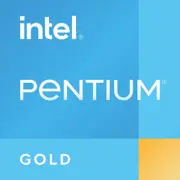Intel Pentium Gold G6400

Intel Pentium Gold G6400: processore economico per compiti di base nel 2025
Aprile 2025
Caratteristiche principali: architettura e prestazioni
Il processore Intel Pentium Gold G6400, lanciato nel 2020, rimane rilevante per le build economiche grazie alla sua efficienza energetica e al costo contenuto. Basato sull'architettura Comet Lake (14 nm), è dotato di 2 core e 4 thread (grazie all'Hyper-Threading), il che gli consente di gestire semplici scenari di multitasking.
Caratteristiche chiave:
- Frequenza di clock: 4.0 GHz (senza Turbo Boost).
- Cache L3: 4 MB — sufficienti per applicazioni di base.
- Grafica integrata: Intel UHD Graphics 610 a 1.05 GHz, che supporta il 4K tramite HDMI.
- TDP 58 W — basso consumo energetico per PC da ufficio.
Prestazioni:
Secondo i test di Geekbench 6 (2025), il processore ottiene 807 punti in modalità single-core e 1677 in modalità multi-core. Questo è un livello sufficiente per lavorare con applicazioni da ufficio, browser e semplici editor grafici. Ad esempio, in Microsoft Office 2025 offre prestazioni fluide anche con grandi fogli di Excel.
Schede madri compatibili: socket e chipset
Il Pentium G6400 utilizza il socket LGA 1200, il che limita la scelta delle schede madri a modelli obsoleti ma accessibili.
Chipset compatibili:
- H410/B460/H470: ottimali per questo processore. I chipset della serie H410 sono i più economici (a partire da 60$), ma privi di PCIe 4.0 e USB 3.2 Gen 2.
- Z490: un'opzione sovradimensionata, poiché il processore non supporta l'overclocking.
Esempi di schede nel 2025:
- ASRock H410M-HDV (65$): mini-ATX, 2 slot DDR4.
- Gigabyte B460M DS3H (85$): 4 slot RAM, M.2 per NVMe.
Importante: Quando si acquista, verificare il supporto del BIOS. Alcune schede richiedono un aggiornamento del firmware per funzionare con Comet Lake.
Memoria supportata: DDR4 e modalità dual channel
Il processore lavora con DDR4-2666 MHz in modalità dual channel. DDR5 e frequenze superiori non sono supportate.
Raccomandazioni per la RAM:
- 8 GB: minimo per Windows 11 e compiti di base.
- 16 GB: lavoro confortevole con 10+ schede in Chrome e montaggio video leggero.
Esempio: il kit Crucial DDR4-2666 16 GB (2x8 GB) costa circa 45$ e garantisce stabilità.
Alimentatori: calcolo della potenza
Con un TDP di 58 W, il Pentium G6400 non richiede un alimentatore potente. Anche considerando una scheda grafica discreta di livello base (ad esempio, GTX 1650), bastano 400–450 W.
Consigli:
- Scegliere un alimentatore con certificazione 80+ Bronze (efficienza del 85%).
- Evitare marchi no-name.
Esempi:
- EVGA 450 BR (50$): affidabile e silenzioso.
- Corsair CV450 (55$): protezione da sovraccarichi.
Pro e contro del Pentium Gold G6400
Pro:
- Prezzo: 75–85$ (nuovo, 2025).
- Efficienza energetica: adatto a case compatte.
- Grafica integrata: non richiede una scheda grafica separata.
Contro:
- 2 core: rallenta con più applicazioni pesanti in esecuzione contemporaneamente.
- Nessun PCIe 4.0: limitazione per gli storage moderni.
- Socket obsoleto: impossibilità di fare un upgrade a processori Intel più recenti.
Scenari di utilizzo: per cosa è adatto il processore
1. Compiti d'ufficio: Word, Excel, email, videoconferenze.
2. Multimedia: streaming video (Netflix, YouTube 4K), musica.
3. Giochi leggeri: Minecraft, CS:GO (con impostazioni basse, 720p), giochi nel browser.
Esperienza reale: Un proprietario di PC con G6400 segnala che il processore gestisce Adobe Photoshop 2025 (editing foto a 12 MP), ma "si blocca" durante l'uso di effetti 3D.
Confronto con i concorrenti
AMD Athlon 3000G (Zen, 14 nm):
- Pro: più economico (60$), moltiplicatore sbloccato.
- Contro: meno performante in compiti single-thread (Geekbench 6 Single-Core: ~720).
Intel Celeron G5900:
- Pro: prezzo (50$).
- Contro: nessun Hyper-Threading, solo 2 thread.
Conclusione: Il Pentium G6400 supera l'Athlon 3000G nelle prestazioni per core, ma perde in termini di prezzo.
Consigli pratici per l'assemblaggio
1. SSD indispensabile: Kingston A400 240 GB (30$) velocizzerà il caricamento del sistema.
2. Raffreddamento: il dissipatore stock è sufficiente, ma per silenziosità si può optare per un Deepcool GAMMAXX 400 (25$).
3. Case: Mini-ITX (Fractal Design Core 500) per compattezza.
4. Non spendere troppo per la scheda madre: H410 sarà più che sufficiente.
Conclusione finale: a chi si adatta il Pentium Gold G6400
Questo processore è la scelta per chi:
- Monta un PC da ufficio o un media center domestico.
- Cerca il massimo risparmio senza sacrificare la stabilità.
- Non pianifica di eseguire giochi AAA o editor professionali.
Alternativa: Se il budget permette di aggiungere 50-70$, considerare l'Intel Core i3-10100 (4 core/8 thread) o l'AMD Ryzen 3 4100 (Zen 2).
Nel 2025, il Pentium G6400 rimane una soluzione di nicchia, ma per i suoi compiti è ancora rilevante.
Di base
Specifiche della CPU
Specifiche della memoria
Specifiche della GPU
Varie
Classifiche
Rispetto ad altre CPU
Condividi sui social media
Oppure linkaci
<a href="https://cputronic.com/it/cpu/intel-pentium-gold-g6400" target="_blank">Intel Pentium Gold G6400</a>